The challenge of eating local food on a budget
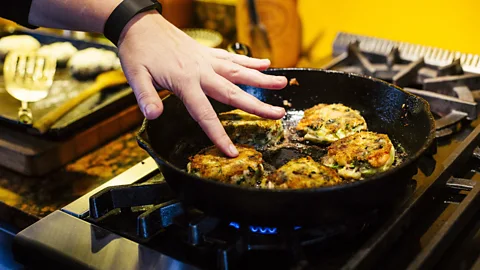 Getty Images
Getty ImagesIn London and LA, we tried eating local food to make our diets more climate-friendly. Here's what happened next.
The assignment seemed simple enough: in a one-week experiment, two BBC Future Planet journalists, one in Britain and one in the US, would eat only local food to try and cut their carbon footprint and make their diet more sustainable.
The global food system is a major source of the greenhouse gas emissions that drive climate change, contributing about one-third of the global carbon footprint. Food miles, in turn, account for around 19% of those emissions. Eating food that's grown close to our homes could, therefore, instantly make our meals more climate-friendly – especially if paired with a plant-based diet to also tackle emissions and biodiversity-loss from food production. Research suggests local choices can also help boost local economies and strengthen community ties.
That's the theory, at least. But what actually happens when you try to eat only locally produced food – does it really make your diet more sustainable? Is eating locally even possible if you live in a big city, on a budget? And what does "local food" really mean?
We put the theory to the test in two cities, each representing a different climate and culture. Lucy Sherriff is based in Los Angeles, California, famous for its abundance of fresh, healthy, sun-soaked produce. The state is the US's sole producer for a number of crops – almonds, olives, raisins, figs – and if California were a country it would be the world's fifth largest supplier of food. So it should be easy to buy cheaper Californian-grown food in California, right? That's what Lucy thought, too – but she was in for a few surprises.
India Bourke is based in London – and before you start joking about British cuisine, consider that Britain is an island that's been farmed for over 6,000 years; it should know something about producing food. Today, however, only 17% of fruit and half of vegetables sold in Britain are grown at home. Is it even possible to live affordably off local British produce anymore?
Here's what happened next.
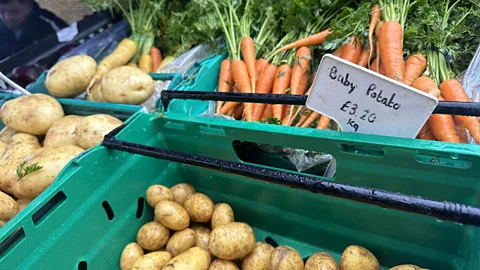 India Bourke
India BourkeIndia, London
Free healthcare, the Beatles, wizarding books: the list of things that Brits can boast to Americans about is small but mighty. As I begin this food diary, I'm hopeful I can add "access to sustainable local food" to their number, based on the nation's long history as resilient islanders.
That said, there is another British reality which can't be ignored: rising food costs. In the wake of the Ukraine war, which pushed up fuel and fertiliser costs, and extreme flooding which decimated crops, food price inflation has soared to near-record highs in the UK. A record number of families now rely on food banks and emergency food parcels from charities. Food insecurity is also a huge problem world-over, and has persisted even in more peaceful, stable times, despite an abundance of produce. It is defined in the US as not having access to adequate food for active, healthy living, and it is tied to a lack of money, mostly affecting poor and single-parent families. It shapes lives from the start: American food insecurity affects 17.3% (6.4 million) of households with children.
Solving food poverty will thus take systemic change at both national and international levels, suggest experts like Tim Lang, professor of food policy at City University London – pointing to the need to reduce inequality and raise disposable incomes so that everyone is able to eat a sustainable diet. But even outside of those facing the deepest food insecurity, the rising cost of produce is also impacting consumer choices more generally, with people reducing what they spend.
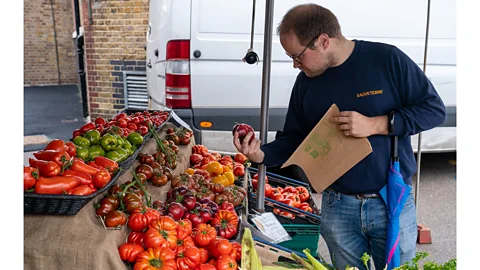 Getty Images
Getty ImagesGiven this challenging wider picture, I decide to make the same frugal dish with staple ingredients every day. I choose "bubble and squeak": a historic British recipe made from fried potatoes and cabbage mashed together, and supplemented with anything from eggs to cheese. The main ingredients are seasonal to the UK at time of writing, in November, which might help with both the sustainability and cost.
On the first day of my experiment, I visit a few supermarkets in my London neighbourhood to compare prices – and at first glance, it looks like I've picked a sensible strategy. There are plenty of options for UK-grown cabbage and potatoes, both organic and non-organic, and the latter are among the cheapest produce on offer. But there's also some niggling problems with my choice. Eating the same meal every night isn't really very realistic, but my knowledge of dishes involving seasonal swedes and turnips is limited. Moreover, the kind of diet that could be good for both people and the planet also requires eating a range of foods, from fruits to nuts, that might not sit within everyone's usual habits – and possibly even involves cutting down on "starchy vegetables" like potatoes. Plus eating meals that are rich in varied fruit and vegetables is tricky when most of the supermarkets' options appear to be from abroad – the UK imports around 95% of its tomatoes, for example.
As I look at the narrow range of UK-labelled options in the supermarket veg aisles, I feel slight envy for Lucy over in lush California, who is surely facing a much easier week.
 Lucy Sherriff
Lucy SherriffLucy, Los Angeles
Here's one of my first surprises: it can be really hard to buy Californian-grown food in California, especially if you're on a budget.
Four out of five of the most productive food-growing counties in California are considered food deserts, meaning, people there have no access to shops that sell fresh, healthy food. How can that be? It's a startling fact I'll come across again and again during my experiment: you can live in an area overflowing with fresh vegetables, and even spend your life watering, weeding, and harvesting them – and yet, be unable to eat them.
One in five Californians are food insecure, even though the state produces almost half of the US's fruit and vegetables. Low-income communities of colour are particularly underserved by shops that sell fresh produce. Finding affordable organic food – grown without pesticides – is even harder. Still, I live in LA, a large city known for its outdoor, healthy lifestyle, with an abundance of supermarkets. Surely I can find some good options?
California's main growing season has ended when I start my experiment, adding a layer of difficulty to my quest, but also, perhaps, making it more realistic. After all, people need to eat in the winter months, too. I choose a mid-range supermarket, and scan the shelves for local produce. Creamy avocados are out – at this time of the year, they're all from Mexico. Cucumbers are from Peru. I find a bag of rocket from the US (exact state unknown), as well as American-bred turkey.
At the next supermarket, I do spot a giant stand declaring "avocados from California!" – but they all turn out to be from Mexico, too, according to the stickers on them. Given that food miles have such a big climate impact, it's frustrating how hard it is for shoppers to find out where their food is actually from. If it weren't for a work assignment, would it even be feasible to spend this much time vetting my groceries?
At the end of the day, I come home with an assortment of goods from all over the US – yoghurt from Wisconsin, Atlantic salmon, and that turkey and the bag of rocket. I did hunt down some California-grown produce: herbs… and a bag of potatoes. Turns out sunny California can be surprisingly similar to rainy Britain, diet-wise. Unless… I'm looking in the wrong place? Maybe supermarkets just aren't a good source of local, affordable food. Would a street market be different? I decide to find out.
 Getty Images
Getty ImagesIndia, London
Lucy is not the only one turning her attention to street markets and direct vendors. In the UK, food-stall markets have been praised for reflecting the UK's varied food-cultures and for offering "affordable healthy food". Many also reduce packaging and promote recycling. Will a trip to a local stall in my neighbourhood reveal options the supermarket may have overlooked?
A nearby stall's main UK-sourced vegetables are – you guessed it – cabbage and potatoes. At the front of the stall is an array of brightly coloured, imported bananas, mangoes and papaya. But just as I start to feel that perhaps there's a trade-off in wintertime London between buying local and eating varied food, I visit a farmers' market – and am completely charmed.
Under an array of soggy food-tents, set up in the car park of a school, huddle some improbably good-humoured sellers. They are eager to chat about their produce. The market's damp air is filled with enticing smells: bubbling stroganoff made with gourmet mushrooms from Essex, home-made dosa wraps, and sizzling vegan dumplings. I buy honey from bees in Epping Forest on the outskirts of London, as well as butter and cheese from a family farm 32km (20 miles) from the London ring road. I feel nourished in all senses and warm under the grey clouds. And buying directly from growers offers a precious opportunity of finding out how my food is produced.
The chatty stall holders are actually a core part of the concept of farmers' markets, according to Sandra Woodfall of the Farm Retail Association, which certifies such markets as "real" and not in-name only. The same people who grow or produce the food must be there to talk customers through the specifics of their processes, Woodfall explains; what feed their animals nibble, which nectar their honey-bees sip.
Speaking to the growers results in a few revelations for me. At one stall, the vendor recommends I buy the "especially good" Brussels sprouts, rather than the cabbage, giving me an exciting new option for my bubble and squeak. But the seller also reminds me that the struggle to access good local food affordably is echoed by the struggle of those producing it. "Cheaply? Yes and no: you can't really pay cheap for quality," he says when I explain my experiment to find sustainable and affordable food. One recent survey found that half of UK fruit and veg farmers fear they'll go out of business in 2024.
"It's so difficult to make a living off the land," Woodfall explains. "[Our] farmers have had to prune the trees and pick the fruit, so it may be more expensive than a general street-market where it's any bowl of fruit a pound, and which has likely been flown in and bought in bulk."
A truly fair system then would need to keep prices low for buyers, while also sufficiently rewarding responsible growers. Is that even possible?
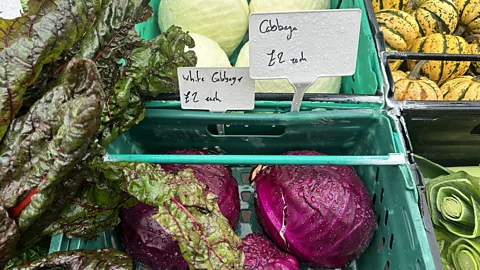 India Bourke
India BourkeLucy dines out in LA
A setback to my local food quest: I have a business lunch, and can't pick the location. I end up at a Mediterranean restaurant that prides itself for flying in food from around the globe: Danish salmon from the Faroe Islands, olive oil from Greece. It's an important reminder that while "local" may be a badge of pride, if you're thinking about food miles, "imported" still carries more prestige in many other contexts. And for restaurants trying to weather the tough economy and pull in customers, it makes sense to sprinkle their menus with tempting treats from faraway locations.
There are also other important reasons why local food may not always be the most suitable option for a business or individual person. An obvious one is cultural diversity, and the joy of eating food and spices from all over the world, or for families rooted in other countries, getting that much-missed taste of home. There's a huge Latino population in LA, making up 48% of the city's 3.8 million people, and countless small shops and markets selling produce from Central and South America that can't be found in supermarkets, such as yucca and a wide range of chillies.
I visit a market relatively close to my home, and find pineapples and yucca from Costa Rica, bananas from Guatemala, and chilis from Mexico, but also, radishes, parsley and watercress grown in the US. In terms of my "buying local" goal, the result is mixed, to say the least. But like India, I find that there are other benefits to visiting the market, such as seeing an inspiring range of produce and learning more about a food culture that's such an important part of LA.
Is there a way of combining my local-eating goal with that kind of community connection? As the final part of my experiment, I try out a community-supported agriculture (CSA) box, a scheme where you can sign up to receive a box of fruit and vegetables delivered to your door, from a local farm. These schemes are meant to keep prices low by cutting out the middleperson and provide farmers with secure customer bases.
The boxes certainly look beautiful: one friend's weekly delivery contains a surprise mix of fresh goodies, including baked rolls, a sweet treat, half a dozen eggs and around 16 different vegetables. It costs… $125 (£99/€116). As India's vendor in the farmers' market said, that may simply reflect what it actually costs to produce food at decent wages. I find one, priced at $37 (£29/€34), that contains persimmons, grapes, kiwis, one squash, two bunches of collard greens, one bunch of beetroot, bok choi, one bunch of carrots, and leeks. It's amazing that all this is grown by a local, family-run farm. As I am writing I am eagerly awaiting my produce – and the opportunity to finally enjoy a regular supply of California-grown food.
It is eye-opening to see that even outside of the main growing season, such a big, flavourful range of produce can be grown here. So why isn't that reflected on supermarket shelves? Partly, it's due to international trade agreements, allowing crops to be imported from abroad without the hurdles countries previous faced. As it's primarily cheaper to grow produce in Latin American countries, imports of fresh fruit and vegetables are on the rise.
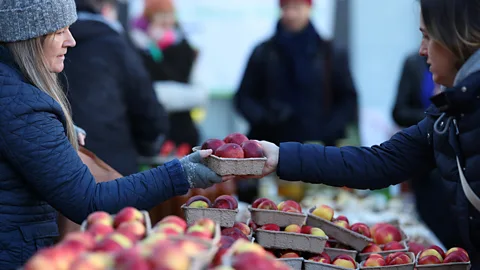 Getty Images
Getty ImagesCARBON COUNT:
The emissions from travel it took to report this story were 0.01 tonnes CO2. The digital emissions from this story are an estimated 1.2g to 3.6g CO2 per page view. Find out more about how we calculated this figure here.
India, London
Community-supported agriculture (CSA) schemes have taken off in the UK, too. They link a community directly to a single farm, often within 24km (15 mile) radius, and often have extended subscription periods of a month or a season, explains network coordinator Suzy Russell. By knowing exactly how much it needs to grow each season, farmers can plan ahead and massively reduce their waste. And while membership carries the risks of bad weather, they also enjoy the benefits of a bumper crop.
Compared to organic produce, the prices can be reasonable, says Ed Hamer, who farms a CSA on Dartmoor in Devon, UK. The organic crops in their farm's veg-boxes work-out around 15-20% below supermarket prices, he says. "CSAs are not accessible to those at the bottom of income scale, who can't commit to a regular scheme. But every scheme I've visited offered subsidised rates - it's a very altruistic culture."
Another way to bring down costs involves so-called "food-hubs". These hubs mimic the supermarkets' economies of scale by buying from local and organic farmers and centralising the distribution efforts for local retailers, explains Rachel Jones from the Sustain Alliance.
By using the nationwide Better-Food-Trader website, I'm able to locate a weekly fruit-and-veg bag which operates through such a food-hub system. The bag costs £10.65 ($13/€12) and is filled with beetroot, four carrots, onions, spinach, a very old variety of apple, and a vast white radish, or "mooli". I'm intrigued by the challenge of using such an unusual range of vegetables and opt to cook a veggie-roast. I also appreciate that it gets delivered to my local pub. As with the farmers' market, chatting to the friendly bar-staff immediately makes me feel more rooted in the place I live.
One of my main insights from trying to eat locally sourced food for a week is thus just how intricately connected our daily meals are to the way we structure our food systems. And that sustainable "local" food should perhaps not just be thought of in terms of reducing food miles, but in terms of growing food in a way that also protects the "local" environment and community in which it was grown.
Equally, trying to make sure everyone has access to good food is not just about the price of a single potato – it's about making sure everyone has enough money to choose the food that's right for them, the knowledge to cook with seasonally available local food, and ensuring that growers are paid fairly, too. Some aspects, such as community, personal connections, and discovering new tastes and dishes, may not traditionally fall into the affordability equation, but they are part of the reason why food is so central and important to our society and economy.
Helping public institutions like schools and hospitals invest in food that serves the public good might be one way for the government to boost these different aspects of sustainable eating, as might increasing support for initiatives like food-hub development, among numerous other policies. But shifting our individual thinking about food and cooking might help too. I can't say I'm 100% there yet on my knowledge of what to do with my latest veg-bag – which is full of seasonal turnips - but it feels good to have begun the journey.
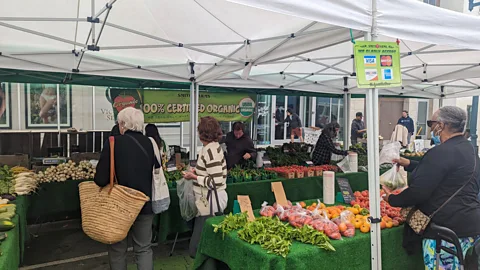 Lucy Sherriff
Lucy SherriffLucy, LA
One of my main insights is that I can do shoestring – by California standards – and I can do local now that I know what to look for. But I can't quite seem to do both. It seems shopping sustainably, at least in LA, is still a luxury for the well-off. Also, doing it affordably is a much more complex subject than simply adding up prices. The time I spent scouring shops and markets for food, and comparing vegetable boxes, is a luxury in itself.
There are other cities in the US that are experimenting with making local food more accessible: urban agriculture is on the rise, New York has vertical farms, and Detroit has neighbourhood farms and community allotments. But these kinds of initiatives are few and far between. CSAs seem to be the best option by far, and as far as I can tell, deserve to be better promoted.
Despite or perhaps because of my mixed results, the experiment has affected me profoundly. I visited a huge range of shops and markets in a single week, and learned so much about LA's and California's food system. I understood the different choices and trade-offs we make when we buy food, and how that connects to other areas of our life and society. And I hope it has changed my eating habits for good. I'm aware of what's in season – and actively research it. I know where I can buy local, and what brands to look for. I ask what's local on the menu in a restaurant. And if it's meat or fish that's from outside the US, I plan to order the vegetarian dish. I'm no longer going to complain if I can't find an avocado in the middle of winter. And I'm going to support my local farmers whenever my budget allows.
--
If you liked this story, sign up for the weekly bbc.com features newsletter, called "The Essential List" – a handpicked selection of stories from BBC Future, Culture, Worklife, Travel and Reel delivered to your inbox every Friday.
